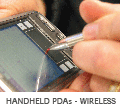Many devices are battery powered, and there is a wide range of battery technologies to choose from: Nicad, NiMH, Lithium, Alkali, etc. They all behave differently and have different caviets. We have designed many products to run off battery power. Often the battery is fixed for the product, however sometimes it is desirable to use a standard battery - such as an AA for example. The problem is there is no guaranteeing which AA a user will use. Nominally an AA battery is 1.5v and the current capacity can vary from 600mAh to 3000mAh. Furthermore rechargeable AA batteries are often 1.2v. A fresh Alkali AA battery can read as high as 1.7v. 3.3v is a common voltage for digital electronics, and it is quite tempting to connect up two AA batteries in series to produce 3.0v and assume that is the power supply sorted. Unfortunately, given the range of AA 'voltages' indicated above, and combined with the fact that battery voltage decreases based on load and capacity, this approach is not acceptable. What needs to be done instead in such a system is to have a boost converter to generate the system 3.3v. On a recent design we used a Linear Tech LTC3539. This works over an input range of 700mV to 5v and can provide up to 2A. If the input is above the system rail - as can happen with some fresh AA cells, the converter still regulates the output voltage (albeit not as efficiently). If the system rail is 3.3v, then the batteries will quickly fall beneath this threshold, so the power loss due to this is not great. If such a chip is used to generate a lower voltage rail, then system operating life will suffer more. Using such a chip to generate a 3v3 rail provides maximum battery life for the system and ensures the majority of energy is drawn from any AA cell before the batteries are 'flat'.

How will TI's OMAP3530 change things?Posted in Industry News on January 05, 2009 by Administrator We have just completed a design based around Texas Instrument's OMAP3530 microcontroller. This is a high-end chip with lots of CPU performance (2000 Dhrystone MIPS) and a built-in 6-core DSP. We have tied it together with 4GB of flash and 256MB of DDR memory and lots of graphics output features to make something which we think will have great application in the digital signage market. So far we have the platform playing MPEG4 video with an alpha-blended overlay. It looks very slick for such a tiny wee board, and we are not even beginning to use the full features of the platform. As the Open Source support for this chip grows, it is going to be interesting to see what develops. The key difference between an OMAP3530 and a desktop PC CPU like the Pentium 4 is the level of integration. The OMAP chip includes a DSP capable of H.264 4CIF resolution full duplex real-time encode and decode, something your average modern PC struggles with. Without the DSP, the OMAP would struggle too. The OMAP chip includes video scaling and rotation hardware, something delegated to the graphics controller in a PC. The OMAP chip includes a NAND flash controller for storage, rather than the SATA used in a PC - but my laptop has a solid state drive which actually includes NAND flash, so the SATA is really just getting in the way. The OMAP chip also has a built-in USB controller, 3D graphics acceleration, SD card controllers and a direct CMOS sensor interface. The PC's processor (Pentium or whatever) uses separate chips, boards or even products for each for these. So the interest question is how long will it take for the PC to head down the integration route? The OMAP CPU is fast enough (or nearly) for most modern PC requirements such as web, email and office documents. For a limited portable screen resolution of 1024x768 or so it puts across a good effort. It seems to me that at least the bottom of the PC market may one day be served by devices such as the OMAP3530 and its successors. As if on cue, Ubuntu and ARM annouced recently that they are working on an Ubuntu release for higher end ARM platforms. “The release of a full Ubuntu desktop distribution supporting latest ARM technology will enable rapid growth, with internet everywhere, connected ultra portable devices,” said Ian Drew, vice president of Marketing, ARM. “The always-on experience available with mobile devices is rapidly expanding to new device categories such as netbooks, laptops and other internet connected products. Working with Canonical will pave the way for the development of new features and innovations to all connected platforms.”The focus is of course portable devices. But I wonder whether in 5 years time we will be using anything else? |



